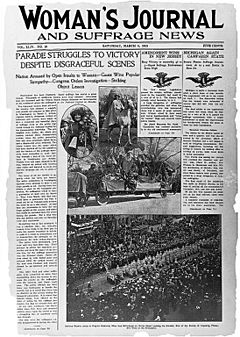Woman's Journal facts for kids

March 8, 1913 front page of the Woman's Journal and Suffrage News depicting the Woman Suffrage Procession of 1913
|
|
| Type | Weekly newspaper |
|---|---|
| Format | Broadsheet |
| Owner(s) | Leslie Woman Suffrage Commission (1917–1931) |
| Founder(s) | Lucy Stone Henry Browne Blackwell |
| Founded | January 8, 1870 (Boston, Massachusetts) |
| Ceased publication | June 1931 |
| Circulation | 27,634 (1915) |
Woman's Journal was an American newspaper that supported women's rights. It was published from 1870 to 1931. It started in 1870 in Boston, Massachusetts. Lucy Stone and her husband Henry Browne Blackwell founded it as a weekly newspaper.
In 1917, the Leslie Woman Suffrage Commission bought the paper. This group was led by Carrie Chapman Catt. The Woman's Journal then joined with two other papers. These were The Woman Voter and National Suffrage News. The new paper was called The Woman Citizen.
It became the official newspaper for the National American Woman Suffrage Association (NAWSA). This lasted until 1920. In 1920, NAWSA changed its name to the League of Women Voters. Also, the Nineteenth Amendment to the United States Constitution was passed. This law gave women the right to vote.
After this, Woman Citizen was published less often. It went from weekly to every two weeks, then monthly. In 1927, its name changed again to The Woman's Journal. The paper stopped being published in June 1931.
The Start of the Woman's Journal
The Woman's Journal began in 1870 in Boston, Massachusetts. It was started by Lucy Stone and her husband Henry Browne Blackwell. They wanted a weekly newspaper to support women's rights. The new paper combined ideas from other publications. These included The Agitator by Mary A. Livermore and the Woman's Advocate.
The first issue came out on January 8. This was exactly two years after Susan B. Anthony's paper, The Revolution, first appeared. Lucy Stone and Henry Browne Blackwell were the main editors. Mary A. Livermore also helped them.
Later, Julia Ward Howe became an editor from 1872 to 1879. Their daughter, Alice Stone Blackwell, started editing in 1883. She became the only editor after her father passed away in 1909. She continued until 1917. Many important people wrote for the paper. These included Louisa May Alcott and William Lloyd Garrison. Around 1887, the paper's office was in Boston on Park Street.
In 1910, the Woman's Journal took over Progress. Progress was the official paper of the National American Woman Suffrage Association (NAWSA). So, the Woman's Journal became NAWSA's official voice. In 1912, its name changed to Woman's Journal and Suffrage News. By 1915, more people were reading it. Its circulation grew to 27,634 copies. This was a big jump from 2,328 copies in 1909.
Becoming The Woman Citizen
In 1917, the Leslie Woman Suffrage Commission bought the Woman's Journal. They paid $50,000 for it. This group was led by Carrie Chapman Catt. The Woman's Journal then merged with two other important papers. These were The Woman Voter and National Suffrage News. The new combined paper was named The Woman Citizen.
This new paper became the official voice for NAWSA. It stayed that way until 1920. In 1920, NAWSA changed its name to the League of Women Voters. Also, a very important event happened: the Nineteenth Amendment to the United States Constitution was passed. This amendment finally gave women the right to vote across the United States.
Rose Emmet Young was the editor-in-chief of The Woman Citizen. Alice Stone Blackwell also helped as a contributing editor. Every member of the U.S. Congress received a free subscription to the journal. The paper wrote about many topics. It covered issues like child labor and, of course, women's right to vote.
After women won the right to vote, the paper's focus changed. It started to teach women about politics. The League of Women Voters wanted to show that women still had power. They also wanted to seem less extreme to women who were worried about radical ideas. So, the journal tried to attract middle-class women readers.
The paper supported the Maternity and Infancy Act of 1921. This was the first big law passed after women could vote. The journal told its readers to support the Act. It encouraged them to write to their representatives. It even gave step-by-step instructions on how to find their lawmakers' names and addresses.
Over time, Woman Citizen was published less often. It went from weekly, to every two weeks, then monthly. In 1927, its name changed back to The Woman's Journal. It stopped publishing completely in June 1931.
Images for kids
See also
 In Spanish: Woman's Journal (periódico) para niños
In Spanish: Woman's Journal (periódico) para niños






